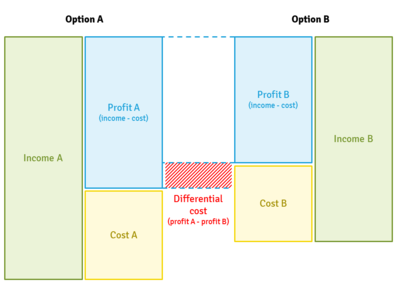Differential costing
| Differential costing |
|---|
| See also |
Differential costing refers to the cost calculation method, which shows the cost difference resulting from different levels of activity, such as the cost of producing one thousand or ten thousand additional product units.
The differential cost is the difference between the cost of two alternative decisions or a change in production levels. The concept is used when there are many possible options to do, and the selection must be made to select one option and drop the others. This concept can be particularly useful in situations related to staged costs, where the production of one additional production unit may require significant additional costs.
The differential cost is the same as the incremental cost and marginal cost. The difference in revenue resulting from two decisions is called differential income (S.Bragg 2017).
Cost - this is a concept understood as an economic category and the value of work which was expressed in the money and resources of the enterprises consumed, at a certain time in order to produce a product (A.Alchian, H.Demsetz 1972, p.777).
Differential cost examples
Here are two examples of main cases of differential costing (S.Bragg 2017):
- An example of alternative decisions:
If you decide to run a fully automated operation that produces 100,000 widgets annually at a cost of $ 1,200,000, or using direct manpower to manually produce the same number of widgets for $ 1,400,000, the differential cost between the two alternatives is US$200,000.
- An example of changing the output:
The work center can produce 10,000 widgets for $ 29,000 or 15,000 widgets for $ 40,000. The differential cost of an additional 5,000 widgets is $ 11,000.
Treatment of Differential cost
The differential cost can be a fixed cost, variable cost or a combination of both. The company's management uses a variety of costs to choose between options to make real decisions that have a positive impact on the company. Therefore, an accounting entry for this cost is not required because it is not an actual transaction. In addition, there are no accounting standards that define the treatment of differential costs (What is Differential Cost?, 2015).
Differential cost applications
Managers use the differential cost as follows (What is Differential Cost?, 2015):
- Define the most profitable level of price and production.
- Offer a quotation at a lower sale price to increase throughput.
Differential cost vs. Incremental cost
These terms can be used interchangeably. The terms mean the same: the cost difference between the two alternatives.
For example, if a company determines that the annual labor cost of US$80,000 machine hours was US$4,000,000, while the annual labor cost of US$70,000 machine hours was US$3,800,000. Then the differential cost or additional cost of an additional US$10,000 machine hours amounted to US$200,000.
The term marginal cost refers to the cost of operation for one additional hour of the machine (What is Differential Cost?, 2015).
Cost type
Costs may be extracted due to (S.Akinyemi 2013, p.49):
- Place of costs
- Business activity
- The sphere of activity
- How to refer the costs to products
- The method of costs reacting to changes in production volume
- Division due to the possibility of control by the centers of responsibility managers
- Classification due to the importance of costs when making economic decisions
- Production costs
- Direct costs
- Indirect costs
References
- Alchian A., Demsetz H., (1972), The American Economic Review, "Production, Information Costs, and Economic Organization ", Vol. 62, No. 5, p. 777-795.
- Akinyemi S., (2013), The economics of education, Strategic Book Publishing & Rights Agency, p. 2-76.
- Bloomsbury Business Library - Business & Management Dictionary, (2007), A & C Black Publishers, p. 2391-2391.
- Bragg S., (2017), Differential cost.
- Jensen M., (1986), , The american economic review, vol. 76, issue 2, p. 323-29.
- Miyata E., (1979), , Derminating fixed and operating costs of jogging equipment, general technical, General Technical Report NC-55. St. Paul, p. 3-14.
- Rajasekaran V, Lalitha R., (2011), Cost accounting, Pearson Education.
- Russel D, Patel A, Wilkinson-Riddle G., (2002), Cost accounting an Essentials guide , Prentice Hall
- Sen A. (2018), , The political economy of targeting, "Theory and method", p. 2-14.
- What is Differential Cost?, (2015), "Financial Modeling and Valuation Analyst".
Author: Joanna Krygowska
.
